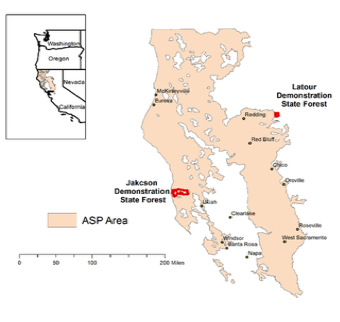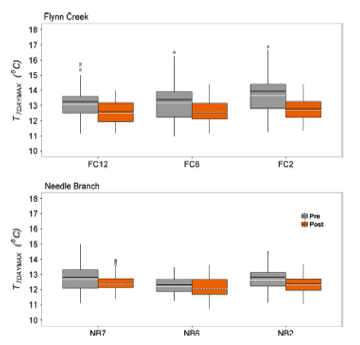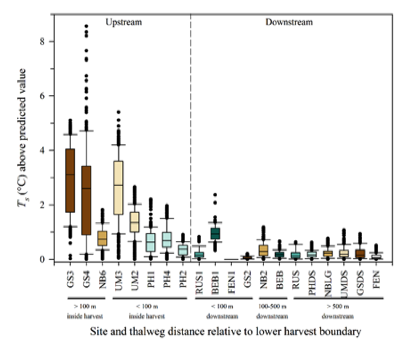

a) Investigate the variability of the relationship between drainage area, active channel width, and perennial flow extent across the Anadromous Salmonid Protection (ASP) area.
b) Compare the relationships derived in (a) to the rule criteria for Class II-L identification in terms of both drainage area and average active channel width; determine if these criteria are effective in identifying Class II-L watercourses in different lithologies, or if rule modifications are needed;
c) Conduct a pilot study to investigate the downstream propagation of water temperature from Class II-L systems in sites with contrasting lithology


Day rolling maximum of stream temperature (T7DAYMAX) during the pre-harvest (2006–2008; gray boxplots) and post-harvest (2010–2012; orange boxplots) years across each site in Flynn Creek (FC, reference) and Needle Branch (NB, harvested).
Observed T7DAYMAX values above the model-predicted values in the post-harvest period. Sites ordered on the x-axis by thalweg distance upstream/downstream from the lower harvest
boundary.
Funded by

Funded by
Effects of contemporary forest practices in stream temperature Oregon (2015-2017)
Multiscale investigation of perennial flow and thermal influence of headwater streams into fish bearing systems in Northern California (2017-2021)
EFFECTS OF HISTORIC AND CONTEMPORARY FOREST PRACTICES IN WATER QUALITY
The impacts of timber harvesting and other land uses on water quality have been an environmental concern for many years. One of the primary concerns is the potential for land use activities to produce increases in stream temperature during the summer and increases in suspended sediment yields during the wet season. Water temperature and sediment are the two primary water quality constituents that have been recognized as the dominant causes of impairment in streams throughout the Pacific Northwest. We investigate the effects of past and contemporary timber harvesting on stream temperature and suspended load considering also the importance of other disturbances such as large storm events and drought.
Publications
19. Bladon, K. D., Segura, C., (*) Cook, N. A., (*) Bywater-Reyes, S., Reiter, M. 2018. A multi-catchment analysis of headwater and downstream temperature effects from contemporary forest harvesting. Hydrological Processes.
14. Bladon K.D, Cook N.A, Light J.T., Segura C. 2016. A catchment-scale assessment of stream temperature response to contemporary forest harvesting in the Oregon Coast Range. Forest Ecology and Management 379, 153-164.
35. *Wissler, A., Segura, C., Bladon, KB., Comparing headwater stream thermal sensitivity across two contrasting lithologies in Northern California, Hydrological Processes, in review, 2020.
30. *Pate, AA, Segura, C, Bladon, KD. Streamflow permanence in headwater streams across four geomorphic provinces in Northern California. Hydrological Processes. 2020; 1– 18. https://doi.org/10.1002/hyp.13889
